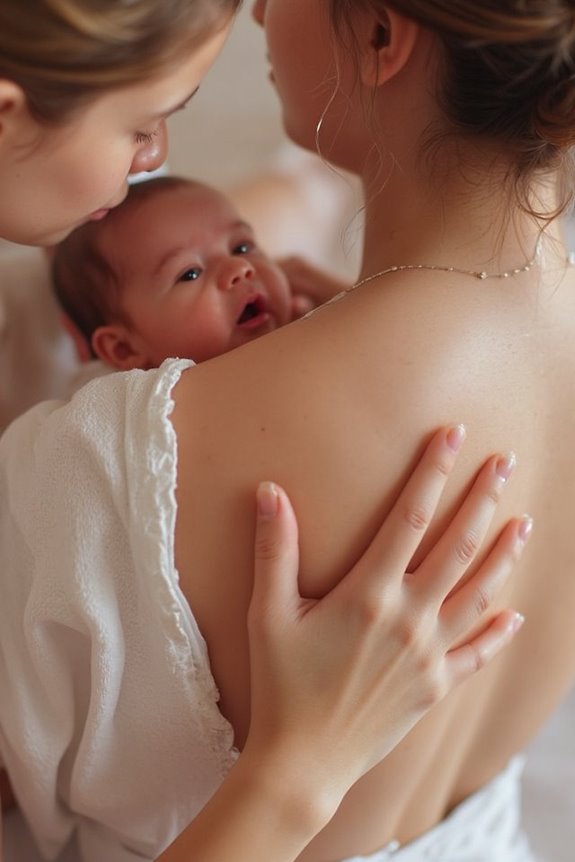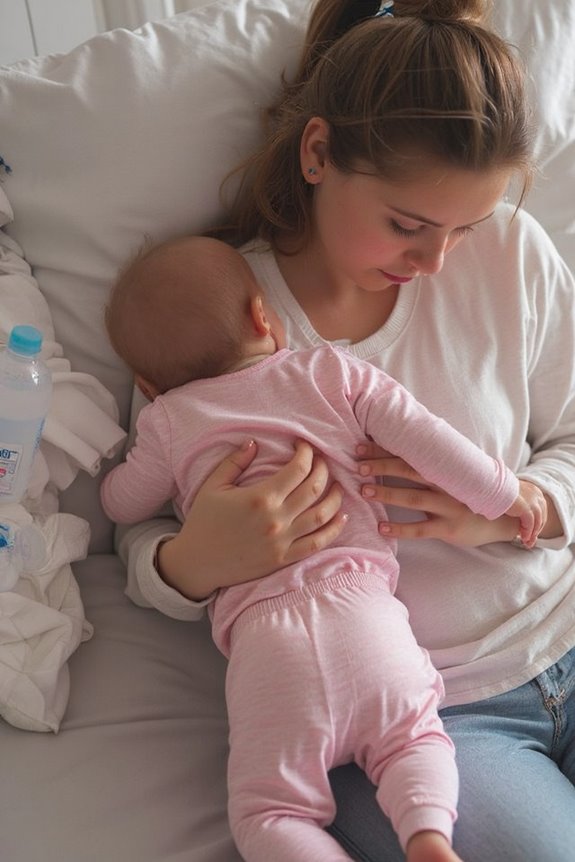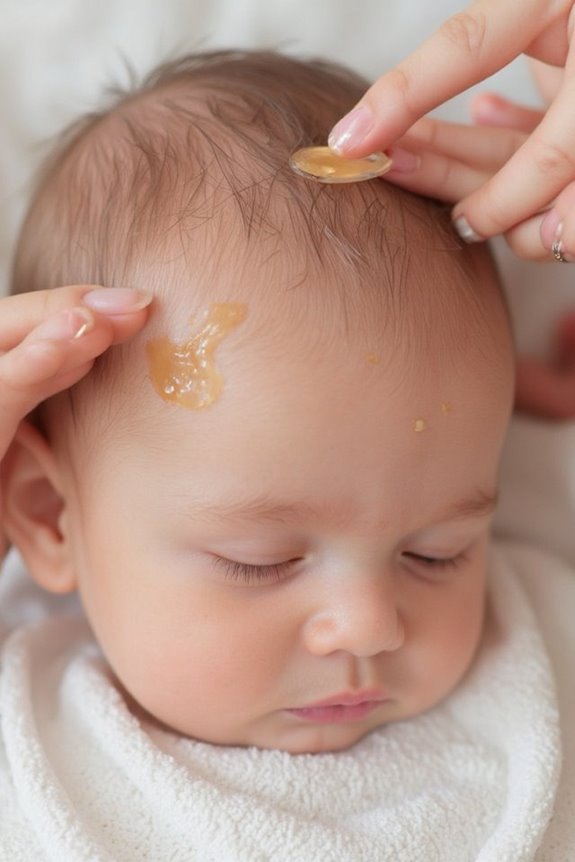Burping helps release air bubbles your baby swallows during feeding. This trapped air can cause discomfort, fussiness, and potential spit-up if not released. I recommend burping mid-feed for bottle-fed babies and after nursing for breastfed infants. While research shows mixed results on its necessity, many parents find burping reduces gas pain and improves feeding comfort. Try different positions—over-the-shoulder, sitting upright, or across your lap—to find what works best. Further techniques can transform your feeding routine.
Key Takeaways
The Importance of Burping Babies
- Burping releases trapped air from feeding, reducing discomfort, fussiness, and potential gas pain in babies.
- Regular burping helps maintain comfortable feeding sessions and promotes smoother digestion for infants.
- Multiple effective techniques exist, including upright sitting, over-the-shoulder, and lap positions.
- Burping halfway through bottle feeds and after completed feedings is generally recommended practice.
- While traditional advice emphasizes burping, recent research shows mixed results on its necessity and effectiveness.
The Science Behind Baby Burping
When your baby feeds, they’re not just taking in milk or formula – they’re also swallowing air that needs to be released. This is a fundamental aspect of baby physiology that directly impacts digestive health.
The burping process serves a critical function: it allows excess air to escape from the upper part of your baby’s stomach through their mouth. Without this release mechanism, trapped air can:
- Cause discomfort and fussiness
- Lead to spitting up or regurgitation
- Move into the intestines, potentially creating gas pain
This physiological process helps maintain comfortable feeding and promotes smoother digestion. While research shows mixed results on burping’s effectiveness for preventing colic, it remains an important preventative measure against common digestive disturbances that can disrupt your baby’s comfort and sleep patterns.
Common Burping Techniques and When to Use Them

Successful burping relies on mastering several proven techniques that you’ll likely need to rotate through as your baby grows and develops. I’ve found that understanding these burping positions can save you considerable frustration during feeding times.
The most effective techniques include:
- Upright Sitting – Support baby’s head while they sit on your lap
- Over-the-Shoulder – Rest baby’s chin on your shoulder with gentle back pats
- Lap Technique – Place baby facing forward on your lap, slightly leaning forward
When to burp depends on your baby’s needs. I recommend burping:
- After each feeding
- Halfway through bottle feeds
- When baby shows discomfort signs
Always use gentle patting motions and keep a burp cloth handy to catch any spit-up that may occur.
Burping Myths vs. Reality: What Research Shows
Despite widespread belief in the necessity of burping babies, scientific research paints a surprisingly different picture than what many parents have been taught. Recent studies suggest that the expected burping benefits are not well supported by evidence.
Key findings include:
- Burping may actually increase regurgitation episodes rather than prevent them
- No significant difference in colic symptoms between burped and unburped infants
- Limited scientific evidence supporting burping frequency recommendations
- Traditional burping advice is often based on custom rather than research
While the American Academy of Pediatrics still recommends burping, their guidance isn’t strongly supported by scientific studies. Understanding these realities can reduce parental stress—you don’t need to worry if your baby doesn’t burp after every feeding. The research suggests it may not be as essential as previously thought.
When Burping Doesn’t Work: Alternative Comfort Strategies

Not every baby responds to traditional burping techniques, leaving many parents frustrated when their little one remains uncomfortable after feeding. I’ve found several evidence-based alternatives that can help soothe your baby:
- Try various swaddling techniques to create a womb-like environment that promotes security and reduces stress
- Implement auditory comfort through white noise devices or gentle shushing near your baby’s ear
- Position your baby on their side or stomach while holding them to provide relief
- Rock or gently bounce while holding your baby close to mimic womb movement
- Create a calming environment by dimming lights and reducing stimulation
These strategies work by engaging your baby’s natural calming reflexes. If your baby continues to show signs of discomfort despite these interventions, consult your pediatrician to rule out underlying conditions.
Tailoring Your Burping Approach to Your Baby’s Needs

While all babies need to be burped, each infant responds differently to various techniques based on their unique physiology and temperament. I’ve found that understanding your baby’s individual needs is essential for effective burping.
Consider these personalized approaches:
- Try multiple positions (upright, across lap, belly-down) until you find what works best
- Adjust burping frequency based on feeding amount and your baby’s comfort level
- Create ideal environmental factors by burping in a quiet space to reduce stress
- Monitor your baby’s response and make adjustments accordingly
For babies with reflux or other health conditions, more specialized techniques may be necessary. Remember to support your baby’s head and neck properly during burping, and don’t hesitate to consult your pediatrician if challenges persist.
Frequently Asked Questions
Can Burping Cause Ear Infections in Babies?
I don’t see evidence that burping causes ear infections in babies. Their unique ear anatomy makes infections more likely, but burping techniques aren’t directly linked – it’s more about feeding position and reflux.
Should I Burp My Baby During Night Feedings?
Ever wonder about nighttime burping? I’d suggest reading your baby’s cues. If they’re comfortable without it, you can skip burping during night feedings. However, if they seem fussy, it’s worth adding to feeding routines.
Do Breastfed Babies Need Less Burping Than Formula-Fed Babies?
Yes, breastfed babies typically need less burping due to digestion differences. When using breastfeeding techniques, your baby controls milk flow and swallows less air, making burping less necessary than for formula-fed infants.
At What Age Can I Stop Burping My Baby?
I’d love to master baby burping techniques forever, but most infants outgrow this need between 4-6 months. Watch for baby milestones like sitting up or rolling over—these show they’re developing their own gas-relief abilities.
Can Improper Burping Contribute to Acid Reflux Problems?
Yes, improper burping techniques can definitely worsen reflux symptoms in your baby. I’ve found that inadequate burping leaves gas trapped, increasing stomach pressure and pushing stomach contents upward, aggravating your little one’s reflux issues.





